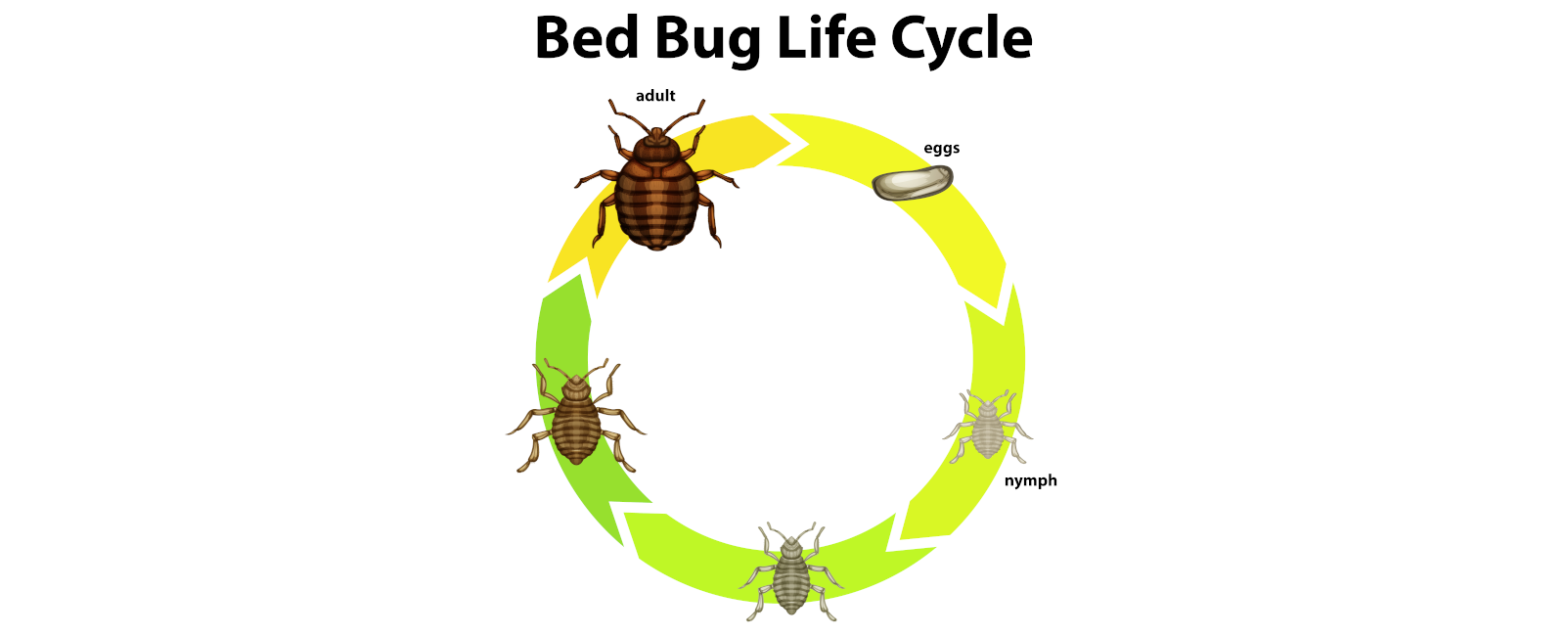Not sure where to start?
Answer a few simple questions and we’ll direct you to your perfect bed.
Enable notifications to get the best news on sales and special offers
Another new day marked by ten new, itchy insect bites? You shouldn’t have to wake up like that. In fact, you can put a stop to it. If you want to know how to remove bed bugs, keep reading. In this article, The Mattress Warehouse asked pest control expert Rentokil to share their expertise on how to get rid of bed bugs. You’ll learn everything you need to know about these mattress monsters, from identifying them to getting rid of them for good!
Bedbugs are small, brownish-red insects that feed on human and animal blood. Almost like mosquitos, but thankfully they don’t fly (or make unbearable zooming noises).
Let’s take a closer look at these little parasites in terms of the following:
Female bedbugs can lay hundreds of eggs in their lifetime. After a male and female bedbug mates, the female must eat blood to produce eggs. A female bed bug typically lays between 5 and 20 eggs per blood meal. Moreover, most of the eggs hatch and mature in 37 days. Also, female bed bugs can store fertilised eggs for some time so they can produce offspring even if there is no male around. Young bed bugs, or nymphs, shed their skins up to three times before reaching adulthood. Moreover, with a continuous food source, bed bugs tend to live for anything between 3 to 6 months. On the other hand, if they don’t have food, they can live up to a year. Strange, right?
Adults can grow up to 7 mm long and 3 mm wide. Depending on where nymphs are in their lifecycle, they can be anything between 0.8 mm and 6 mm in length with a proportionate body width. Lastly, bedbug eggs are so small that they are hard to spot with the naked eye.
Bed bugs are shaped much like flattened apple seeds. Because they are thin and flat, they can easily squeeze into tight spaces. Adults are normally reddish-brown in colour and their bodies get longer and more red after feeding. On the other hand, nymphs may be tan, yellowish or nearly transparent (if they haven’t fed on blood yet) and they are much smaller than adults. The eggs are pearly white and normally clustered together.
Bed bugs will feed on any warm-blooded mammal but humans are much easier targets because we aren’t covered in fur. Unlike fleas and ticks, bed bugs do not live on their hosts. They prefer to lurk in dark, hidden away places close to where their prey sleeps. Then, when night comes, they can travel to their feeding ground (that’s you) with minimum effort. Some of these dark places include:
Yes, there are close to 90 types of bed bugs on planet earth. However, you will most likely only ever deal with the two most common species of bed bugs:
Are they seasonal?
No, bed bugs are not seasonal. But like most insects, they do tend to breed faster in warmer climes.

From egg to adult, there are five stages in the bed bug life cycle.
Apart from the fact that you might have an allergic reaction to bed bug bites, they are not very harmful to people. So far, there have been no documented cases of bed bugs carrying or transmitting serious diseases from one host to another. So if you do have a bed bug infestation, the good news is that you’re unlikely to get ill from their bites.
However, bed bugs tend to leave behind a cluster of bite marks that can be very itchy. Moreover, if you have sensitive skin, you might scar from bed bug bites or from scratching the bite marks too severely. These little parasites don’t have a preferred body part that they like to feast on, apart from easily accessible skin.
Bed bugs hatch from eggs, but these eggs don’t simply roll into your home. So how do you get bed bugs? Where do they come from and how do they end up in our homes? The answer is easier than you might think. Bed bugs love to travel. They crawl into your luggage when you visit a hotel or they hop on your shoulder while you sleep in a busy hostel.
Because bed bugs are so small, they can find all sorts of interesting places to hide and wait for new prey. Remember, they prefer to feed on human blood and as such, they tend to live in places where a lot of people come together to do relatively low-energy activities. For instance, sleep. That is why one of the most common places to pick up bed bugs is in hotels and hostels.
And no, bed bugs do not only thrive in dirty, unhygienic places. You can find bed bugs in the most immaculate hotel room just as easily as in a busy, low-budget youth hostel. Of course, clutter in a bedroom doesn’t help because these pesky pests like to hide in dark spots. If there are a lot of shoes, books, and clothing lying around, you are creating optimal hiding spots for bed bugs.
Holiday living destinations aren’t the only place where you can pick up these unwelcome guests. Here are other common spots where you could pick up bed bugs:
Basically, where people lie- or sit down for long periods of time.

Plush carpets and curtain folds are perfect hiding spots for bed bugs.
Interestingly, bed bug infestations tend to increase around large sporting events, like the Soccer World Cup or Olympic Games. When a lot of people from all over the world come together in one place, a couple of travellers are bound to bring along a bed bug or two. Moreover, with increasing urbanisation, bed bug numbers in cities also seem to be on the rise.
You might also be wondering…
These nocturnal feeders are attracted by body heat and the carbon dioxide that you breathe out, so they will only come out of hiding if there is a human or animal to feed on. As such, it is not an easy task to find them. However, if you wake up with a couple of new insect bite marks regularly, you might have bed bugs. And then there are a couple of things to check for before you start asking how to get rid of bed bugs.
If you find any or all of the abovementioned evidence, it would seem that you have a bed bug infestation. Now what you need to do is to find an actual bed bug.
This is where you need to remember their preferred living environment. So take out your magnifying glass and very carefully look in your mattress seams, around the buttons in your upholstered headboard, in the gaps between the floor skirting and the wall, and so on. In general, if the thin side of your credit card can fit into the space, a bed bug can snuggle up in there too.
There are two approaches to getting rid of bed bugs. You can attempt to do it yourself or you can get in the professionals to take care of it for you. If you are a homeowner with bed bugs in some of your bedrooms, the DIY option is viable. But if you are in the hospitality industry and your hotel or hostel is infested by bed bugs, we suggest you seek professional help to get rid of the pest.
Once you’ve identified the rooms in which the bed bugs reside, restrict movement from those rooms to others to avoid the spreading of the bugs. Then, in an all-out effort, do the following:
Use a commercial household-approved pesticide that indicates it can be used to get rid of bed bugs. Read the instructions carefully and apply the pesticide wearing appropriate PPE. Take note that bedbugs are resilient and resistant to some pesticides, so this option might not work. Moreover, some pesticides can be harmful to pets and humans so use them with extreme caution.
Pest control experts, like Rentokil, have years of experience in identifying and exterminating bed bugs. They know exactly where to look and what to look for.
Rentokil follows the principles of integrated best management when it comes to eradicating pests like bed bugs. If you decide to call in our help, we will do the following:
Please note that in hotels, all of the rooms adjacent to the one where bed bugs were identified must also be treated to ensure that the infestation does not spread. That means that rooms above, below, next to, and across the hallway from infested rooms will also need to be treated.
Here are some tips to prevent future bed bug infestations:
Getting rid of bed bugs can be an iterative process. If you don’t clean out all of their eggs, a new generation of bed bugs may be born into your home or hotel after you got rid of the first set of intruders. So you should be vigilant after the first sweep to ensure that no large-scale resurgence occurs.
Striving to improve your sleep hygiene, The Mattress Warehouse supplies sleep tips and more importantly, top-quality beds and bedding. Follow us on our blog or social media for more tips on how to improve your sleeping environment. Sleep tight, don’t let the bed bugs bite!
Rentokil is a professional exterminator company with over 90 years of international experience and 50 years of local experience in South Africa. The company is committed to protecting people from the danger of pest-born diseases and illnesses. Expert technicians are trained to understand the biology of pests in order to apply the best possible treatment plan for your home.
Disclaimer: The views and opinions expressed in this article are those of the author and do not reflect the views of The Mattress Warehouse.
Why Single Beds Are Making a Comeback: Secrets to a Functional Home
From Dorm Room to First Apartment: Why a Double Mattress Is Ideal
Double Beds: Memory Foam vs. Spring Mattresses Pros and Cons
Compact Solutions: 5 Best Couch Beds for Urban Living
Caring for Your Headboard Set: Essential Maintenance Tips
How to Match Your Bed Headboard to Your Bedroom Decor
The King Size Bed: Key to a 5-Star Sleep Experience
Size Guide: Finding the perfect mattress for your Queen bed
Affordable Bed Sets: What Makes it Worth the Splurge?
Local Treasures: Unveiling the Best Bed Mattresses for Sale Nearby
Why Single Beds Are Making a Comeback: Secrets to a Functional Home
From Dorm Room to First Apartment: Why a Double Mattress Is Ideal
Double Beds: Memory Foam vs. Spring Mattresses Pros and Cons
Compact Solutions: 5 Best Couch Beds for Urban Living
Caring for Your Headboard Set: Essential Maintenance Tips
How to Match Your Bed Headboard to Your Bedroom Decor
The King Size Bed: Key to a 5-Star Sleep Experience
Size Guide: Finding the perfect mattress for your Queen bed
Affordable Bed Sets: What Makes it Worth the Splurge?
Local Treasures: Unveiling the Best Bed Mattresses for Sale Nearby